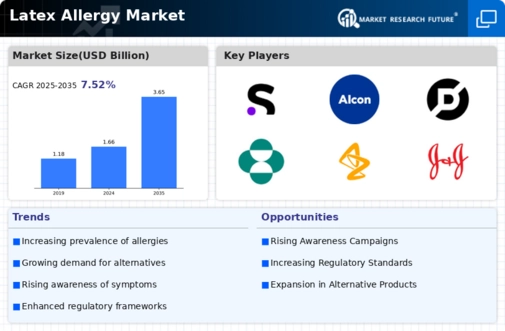Market Trends
Key Emerging Trends in the Latex Allergy Market
The Latex Allergy market is witnessing a surge in awareness and diagnosis of latex allergies. Healthcare professionals and patients alike are becoming more informed about the risks and symptoms associated with latex exposure, leading to early detection and better management of latex allergies. With the advancement of the market, one has to note that a large percentage of latex allergy is traditionally found in the health care facilities. A special group of people include health care workers, patients during the surgical procedures, as well as those who have been numerous contacts with latex-containing medical apparatuses show significant risks for developing reactions to AM. This trend confirms the essence and need of preventive actions in comparison to other products, used in healthcare setups. One of the changes occurring in the market is the high demand for latex-free products from different fields of production. Allergy developments have promoted a move from standard glove, medical and customer merchandise materials towards alternative products due to the reduction of items in these occupational environments. With changes in the trend of the market, innovation is observed on various means for latex allergy testing that will improve the accuracy of the giving diagnosis. Modern diagnostic technique increased the accuracy of the detection of latex allergies because it comprises specific IgE blood tests and skin prick tests where they are able to identify latex allergy at an early stage, when precautions can be taken. The patient education and initiatives aimed at public advocacy are helping to alter the market dynamics. The individuals with latex allergies and patient advocacy groups are also doing everything within their power to sensitize the public, promote safer practices as well as demand for earlier alternative methods or have been used in various sectors that influence one’s products of choice and policies. The area of interest for the Latex Allergy market has been enlarged, and now reac up beyond healthcare to elements like food service establishments, factories and consumer products. This indicative is value-added wider market growth due to latex allergy risks in various work environments, as well as activities of daily living; development of latex-free methods. Technological advancements are contributing to the development of innovative latex-free materials. These materials aim to replicate the desirable properties of latex without causing allergic reactions, offering alternatives for manufacturers seeking safe and effective substitutes for latex-containing products.









Leave a Comment